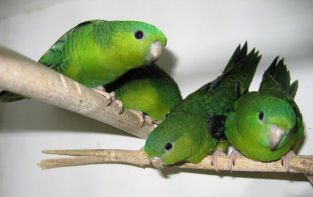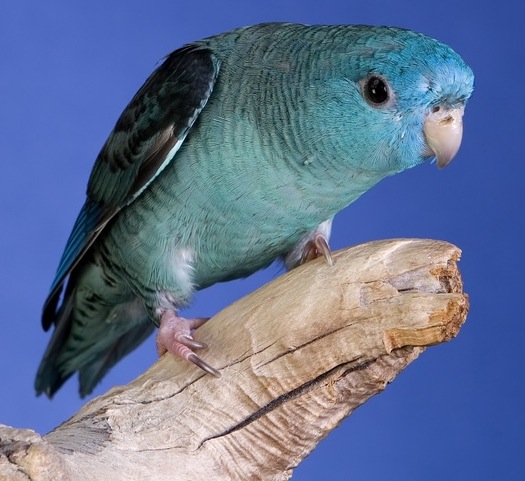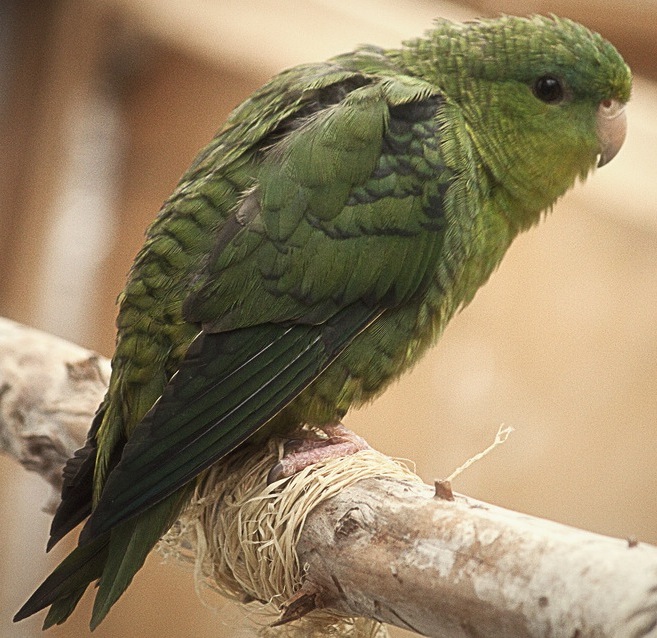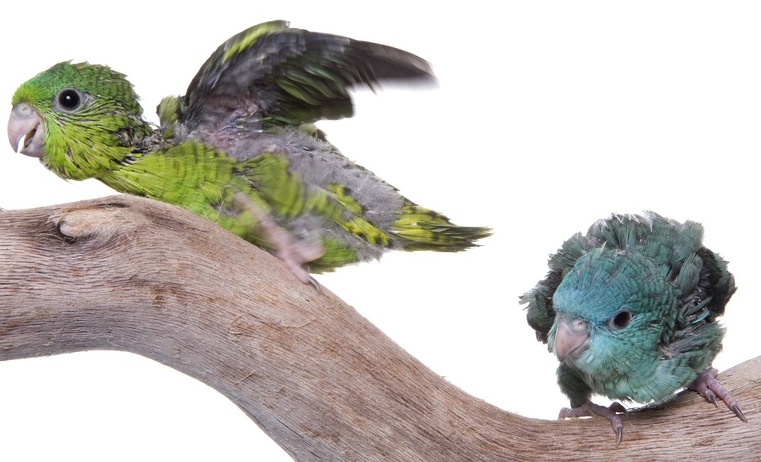Lineolated (barred) parakeet (Bolborhynchus lineola)

Origins: From Mexico south to Panama. Also present in the north-west of South America, in parts of Venezuela and the Andean region of Peru.
Length: 18cm (7in).
Appearance: Also sometimes called the barred parakeet because of the irregular black barring seen on its otherwise green plumage, which tends to be more yellowish on the head (see below, second left. Photo courtesy Timo Helgert). The degree of barring varies naturally between individuals and is not a sign of sexual distinction, although it is often the case that cock birds are more heavily marked in this way.
DNA sexing will otherwise be necessary to distinguish between cocks and hens. Alternatively, if they are housed in a group, then they will pair off naturally. Young birds (seen above, photo courtesy Weena) show less barring than adults and have a bluish tinge to their head plumage.
Variant: Barred parakeets from Peru, forming the subspecies B. l. tigrinus, are more heavily barred with black, as reflected by their name which is suggestive of a tiger's stripes.

Colour forms: Blue and dark factor mutations are now well-established, resulting in the appearance of both a normal blue (also called the turquoise, because of its slight green suffusion) and darker shades, such as cobalt and Mauve lineolated (barred) parakeetmauve (photo courtesy Weena).

Corresponding green series shades - dark green and olive - have also been developed. Lutinos are now readily available as well and a cinnamon mutation has also been recorded.
There is a cremino variety too, with creamy plumage and red eyes, like the lutino, and an increasing number of colour combinations, combining different mutations, such as the cinnamon dark green for example.
Sociability rating: Highly social, to the extent that these parakeets, which are often simply called 'linnies', can be bred well on the colony system. This may not be adviseable in the case of the colour mutations however, since set pairings will be better in these cases if you are wanting to breed similar offspring.
Suitability: Ideal for the typical suburban garden aviary, these parakeets will not inflict great damage on the aviary woodwork nor will they prove a disturbance in the neighbourhood. Their small size also means they can be housed in indoor flights or spacious flight cages, often proving very tame if acquired as youngsters. They may even breed in these surroundings.

Care: Hardy once acclimatised, often occurring at relatively high altitudes in the wild, but will benefit from a snug shelter. May choose to roost in nest box overnight. Can also be kept as pets in a spacious cage or small indoor flight. Young birds especially may learn a few words, although their powers of mimicry are not as good as those of the budgerigar.
Feeding: A typical parakeet diet comprised of the smaller cereal seeds plus sunflower in limited amounts, as well as a supplement to compensate for the nutritional shortcomings in seed, or alternatively a complete diet. Fond of greenstuff such as chickweed and some fruit, especially apple and blackberries.
zzz Breeding: If breeding these parakeets on the colony system, place all the nest boxes at a similar height to avoid possible disputes over the highest nesting site. Lineolated parakeets often breed more reliably in a group. Budgerigar-type nest boxes are suitable, although these should be lined with non-toxic wood shavings rather than a wooden concave.
Softfoods such as canary egg food will often be taken, particularly by breeding pairs rearing chicks. This should be provided fresh once or twice a day.
Breeding data: Three to six eggs. Incubation carried out by the hen alone lasts 18 days. Fledging occurs approximately five weeks later.
Caution: Feather-plucking of the young in the nest may sometimes occur, but the plumage of affected chicks should soon regrow, although try to avoid them becoming chilled at this stage.
v Potential lifespan: Can be 10 years or so.
Did you know? Lineolated means 'lined', and refers to the black stripes of these parakeets.